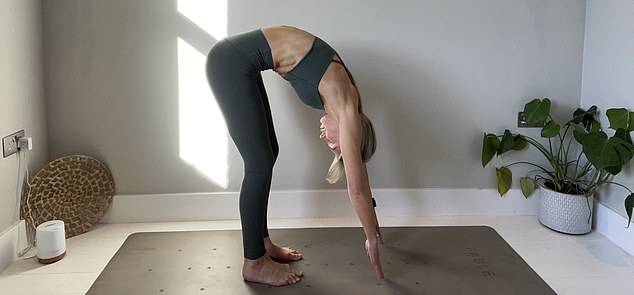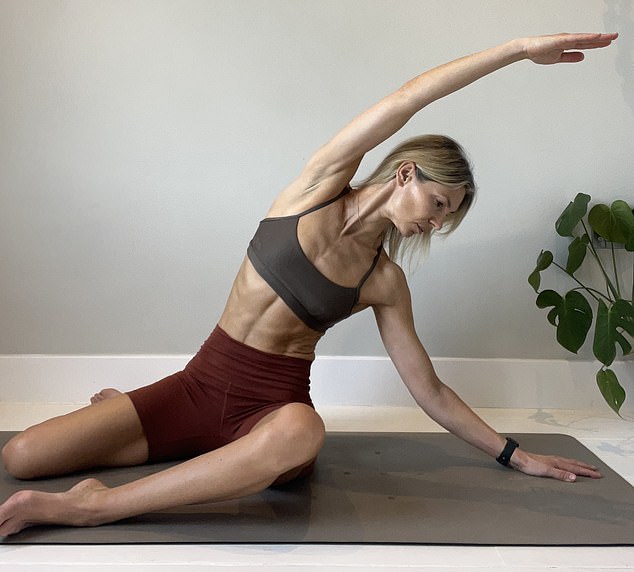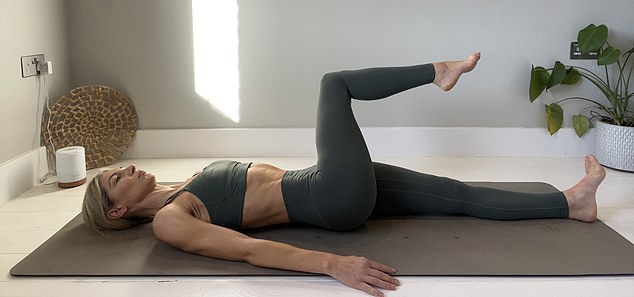Ever find yourself going through a choreographed practice session that’s harder to follow than advanced math?
“Everyone’s had a class – it could be pilates or step aerobics or dance – where you get a bit confused,” says fitness instructor Gemma Folkard. ‘Don’t worry, it’s actually doing you good.’
Yes, the big bonus is that you are working your brain and body. That’s why Shape Pilates founder Gemma teaches what she calls ‘Neuroblast Pilates’, ensuring her students strengthen their muscles and minds.
“Any mat-based exercise, but especially Pilates, where the choreography requires you to remember and execute complex movements, can dramatically increase your cognitive function,” she says.
Gemma explains that her complex Neuroblast Pilates sculpting of the biceps and bottom is also a challenge for the brain. “You often have to interpret and adapt movements and transition smoothly from one movement to another.” [known as flows] requires quick thinking. Neuroblast Pilates is a really effective way to connect mind and body.’

Fitness instructor Gemma Folkard explains that complex Neuroblast Pilates sculpting of her biceps and bottom is also challenging the brain
At the same time, the need to retain complex information stimulates the brain’s memory centers, so if you practice it regularly, Neuroblast Pilates can help improve both short- and long-term memory by strengthening neural connections and even creating new ones.
And of course, physical activity has inherent benefits. “You’re getting more blood flow to your brain,” says Gemma, as well as improving your balance, coordination and spatial awareness. And crucially, she says it’s not all work, no play. ‘It’s also fun.’

Gemma recommends placing your fingertips on the floor, getting more oxygen to the brain while improving balance, coordination and spatial awareness

By practicing these movements, you are stimulating both sides of the brain, strengthening the neural pathways between them, so you are building resilience in both mind and body

Mermaid Side Stretch: Sit on the ground with your right leg in front of you and your left leg out to the side. Bend your knees, with your right shin horizontal to your torso and your left shin extending behind you

One Leg Circles: Lie flat on your back and lift your right knee. Slowly circle your thigh bone four times as if you are drawing circles in the air with your right knee. Switch legs and repeat
Below, Gemma demonstrates two of her Neuroblast Pilates flows – seamless transitions between movements – that will benefit your back, glutes, abs and all-important brain cells.
The first flow
1. Overload your stability
Kneel on a mat and rub your hands together until you feel warm. Doing this increases proprioception – the brain’s sense of the spatial position of the various body parts, which is important for good coordination.
Coordination and proprioception are crucial to everyday life. What appear to be simple things, such as avoiding obstacles when walking down the street, require spatial awareness and become more difficult as we age. Practicing these skills can delay cognitive decline and keep us fit and youthful.
Then get on all fours, knees under hips and heels on hands under shoulders. No sagging torsos allowed. Extend your left arm and right leg – so that your left arm is extended in front of you, touching the mat, and your right leg is pointed, toes touching the mat.
You are already working on the left and right side of your brain. Slide both back to starting position, then out and in. Your right arm works hard to stabilize you – keep your right elbow flexible.
2. To increase the balance
Begin in an extended position as practiced in the previous exercise, opposite leg and arm extended. Then raise the extended arm and place the fingertips to the forehead – as if you are saluting. Your shoulders should be square.
Then lift the other leg and bend the knee so that your thigh is horizontal, in line with your torso and your foot is pointing up in the air.
Then curl under, round your spine, pull your head and elbow toward your knee—create a little ball—and extend both arm and leg back out. The knee stays bent. And repeat – on both sides. Lots of balancing going on here! This is great for the brain as balance requires it to process sensory information quickly and efficiently.
Activities that challenge balance stimulate various brain regions, including those responsible for motor control, coordination, and perception. This stimulation can increase overall cognitive function by keeping these brain regions active and active.
3. To challenge memory and coordination
If that’s not enough for your brain (it’s not), we’ve got more to add. Extend your left arm and right leg. From here, bring your left arm down to your hip, where your leg also lowers.
Then lift your leg up, swing your arm back around so it’s stretched out in front of you, then bend your arm and bring your hand to your forehead as if in a salute, while bending your knee (at a right angle, so your calf and leg are perpendicular. )
Then curl under, bringing elbows to knees, then lift and extend. And go back, find your flow. You are working your stomach and your focus and concentration work your brain!
Then crawl under, bringing elbows to knees, then lift and extend. And go back, find your flow. You are working your stomach and your focus and concentration work your brain!
If that’s not enough for your brain (it’s not), we’ve got more to add. Extend your left arm and right leg. From here, bring your left arm down to your hip, where your leg also lowers. Then lift your leg up, swing your arm back around so it’s stretched out in front of you, then bend your arm and bring your hand to your forehead as if in a salute, while bending your knee (at a right angle, so your calf and foot are perpendicular. ) Then crawl under, bring elbows to knees, then lift and extend.
And go back, find your flow. You are working your stomach and your focus and concentration work your brain!
Then lift your leg up, swing your arm back around so it’s stretched out in front of you, then bend your arm and bring your hand to your forehead as if in a salute, while bending your knee (at a right angle, so your calf and leg are perpendicular. )
Then crawl under, bringing elbows to knees, then lift and extend. And go back, find your flow. You are working your stomach and your focus and concentration work your brain!
The second flow
4. Head rush!
Getting more oxygen to the brain: we start this flow by standing on the left side of your yoga mat, feet in line with your hips, hands clasped in front of you.
Lift your right heel, then step into a wide side lunge. When you bend, your knee should be above your middle toe. Hinge at the hip so that the back is at a 45 degree angle. Bend deeply to stretch your inner thigh.
Then return to your starting position. Spring down, spring up! Your left leg supports you. Root it down like a nice sturdy tree trunk. Can you feel your blood pumping? Excellent! And repeat on the other side.
5. Time for cross pattern flow to work both sides of the brain
This is helpful because cross training patterns involve movements where the limbs cross the midline of the body. These types of exercises engage both hemispheres of the brain and have multiple benefits for brain health.
These include everything from stress reduction due to distraction (concentration helps with this), processing speed and the ability to move smoothly in different directions.
Once you’ve perfected the side throw, we’ll introduce a cross pattern flow. Return to your starting position and lift your right knee so your thigh is horizontal and tap that knee with your left hand.
Then we take the same leg behind us – pointing the right toes to your left buttock – and hit the right leg with the left hand. Then bring your right leg back in front to the starting position – and lunge to the side. Jump back up, lift your right knee – and tap with your left hand.
Is it getting easier? You are working on your hips, glutes and quads. You are also stimulating both sides of the brain, strengthening the neural pathways between them, so you are building resilience in both mind and body.
Congratulations on completing your first Neuroblast Pilates workout – you get an A-star!
* You can find out more from Gemma Folkard at: https://shape-pilates.com and https://apps.apple.com/gb/app/shape-pilates-london/id6535696127
#Featured #FiveStep #Neuroblast #Pilates #Routine #AntiAges #Body #Brain